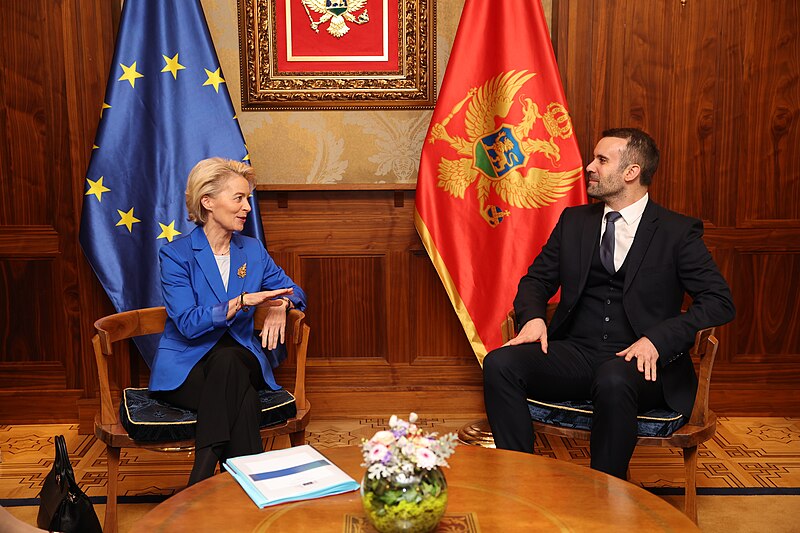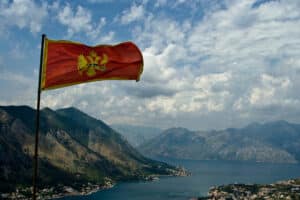Photo: Ursula von der Leyen and Milojko Spajić – Wikimedia Commons
Almost five months after the parliamentary elections, Montenegro has installed a new government. The new coalition is headed by Prime Minister Milojko Spajić from the winning Europe Now Movement and consists of pro-European, pro-Serbian and Albanian-minority parties. The long formation indicates the precarious political situation and playing field of the country. With such opposing parties sharing power, the question arises how long this coalition will stand firm.
Political landscape
Montenegro has known a politically turbulent last couple of years, with the fall of two governments. Parliamentary elections were held on June 11 and won by the centrist Europe Now Movement (PES) with 25,6 per cent of the votes. The Democratic Party of Socialists (DPS), which ruled the country from 1990-2020 came in second (23,2 per cent). Europe Now was formed only a year ago and runs on the pledge of economic reform and joining the European Union as soon as possible. Montenegro is candidate member since 2010 and accession talks have started in 2012. Europe Now’s leader Spajić had excluded DPS from a possible coalition, as all the current problems have emerged during its reign. Spajić set out four main priorities for the country under his leadership: “full membership in the EU, active, credible membership in NATO, improvement of good relations with neighbours and strengthening of the country’s role in multilateral organisations”.
Financial plans
The economy of Montenegro currently runs on tourism and remittances, accounting for around 25 and 10 per cent of GDP respectively. The country’s economy is poorly diversified and slow implementation of prescribed economic reforms complicates EU integration. During the campaign, Europe Now has promised the Montenegrin people higher wages and pensions and economic reforms. Spajić has a vision of Montenegro as “the Switzerland of the Balkans and the Singapore of Europe”. “Our economic policies will aim to improve the living standards and include reforms enabling more fiscal revenues, investment and a better business climate,” he added. Spajić’s short term plans to improve household spending will increase Montenegro’s public spending vastly. Montenegro’s treasury will be overexploited and state debt will increase. Montenegro’s government debt has been steadily decreasing in the last three years after a peak in 2020 of over 100 per cent of its GDP, towards the EU norm of 60 per cent of GDP government debt. Huge economic investments will revoke this positive development. The hope is that these huge public investments in the economy and its people will indirectly strengthen the country’s economy. It is however more probable that these short-term measures will prelude economic fragility and public frustration.
Geopolitical implications
Spajić’s demands are clear, but the composition of the coalition complicates the matter. The new coalition is led by his pro-European party but in order to reach a majority, he had to go consult with For the Future of Montenegro, a pro-Serbian political alliance. The outcome of the formation process is that its leader, Andrija Mandić, will be taking the post of President of the Parliament and the party will fill four ministerial posts. Critics fear Mandić will hinder the country’s EU aspirations and change Montenegro’s foreign policy orientation. He has proved to be a friend of Serbia’s Vucic and Russia’s Putin. He wants to lift sanctions against Russia, has opposed Montenegro’s NATO membership and voted against Montenegro’s declaration of independence from Serbia in 2006. He has been sentenced to jail terms by the court over an attempted coup in 2016 to prevent Montenegro from joining NATO. The DPS that is forced into the opposition, protested against Mandić’ new position over his anti-NATO, pro-Russian attitude. The great difference in direction between the two main coalition parties could constrain the country’s politics due to increasing political polarisation, especially its pro-European course. Although the EU has warned Spajić about working together with some anti-Western parties in the new government, EC president Von der Leyen still calls Montenegro an EU ‘frontrunner’.
Composition
Considering the diverse composition, the new coalition will soon be tested on its ability to live up to the promised reforms. The new coalition consists of nine parties in total, being subdivided in six alliances. It seems unlikely that Europe Now will be able to implement its campaign promises with all the parties’ opposing ambitions. Its promises made during the campaign follow a somewhat populist rhetoric consisting of hands-on economic support for the people, one that often cannot be put into reality easily. Meanwhile, opposition parties accuse the new coalition of just working in Serbia’s interest – Europe Now’s electorate is predominately pro-Serbian and the party is supported by the Serbian Orthodox Church. It symbolises the polarised political atmosphere in Montenegro.
The new coalition resembles the struggle of EU rapprochement in a country that has a large Serbian minority. Being composed of six parties/blocs, internal frictions will put the newly formed coalition to the test on many occasions. Montenegro has experienced a set of tumultuous political years lately and a stable political period is not expected in the coming ones.
Written by Timon Driessen



